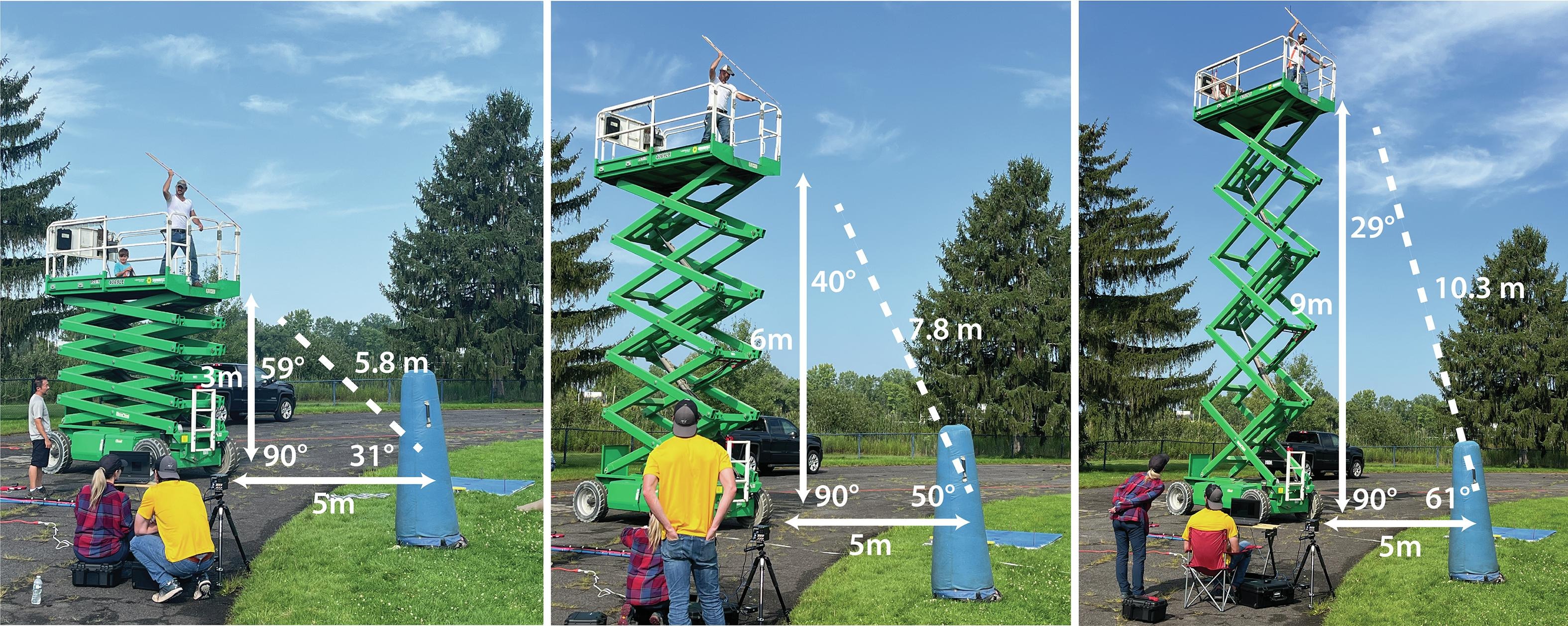Spears work better when thrown from a height, but a surprising study finds the same does not apply to weapons launched from an atlatl (spear thrower). This could explain the apparent non-adoption of throwing devices by Neanderthals. Although there is nowhere near enough evidence to adopt such a conclusion with confidence, it’s possible that such a failure may have placed Neanderthals at a disadvantage in competing with Homo sapiens.
One of the most basic principles of warfare is to try to claim the high ground. Where it’s not available naturally, generations of warriors built castles instead, before taking to the air.
The advantages gravity provides seem so basic and universal it is somewhat surprising researchers at Kent State University even bothered to test them. Nevertheless, they did, standing on a scissor lift and launching sports javelins that resemble spears found at Paleolithic sites. The results were predictable: javelins thrown from 9 meters (30 feet) in the air flew 30-40 percent faster and penetrated deeper into a target than those launched at ground level. Intermediary heights produced intermediate results.
Hunters would have found it easier to drive their points deeply enough into large prey to reach a vital organ from above. In doing so, a Stone Age hunter would have avoided the need to get close enough to enraged prey to strike without throwing; something natural selection would look kindly on.
One of the paper’s authors throwing a javelin at a target from different heights.
Yet when the team experimented with a more advanced technology known to have been used during the last ice age, they found something unexpected. The grooved stick known as the atlatl provides extra leverage when launching lightweight spears (known as darts), allowing for much faster flight than is possible with an arm alone. Surviving hunter-gatherer cultures use varieties of atlatls, such as the Indigenous Australian woomera. Some pet owners use something similar to increase the distance they can throw tennis balls for dogs to chase.
For all these advantages, darts hurled from an atlatl were no faster when thrown from greater heights, the authors found. Indeed, for one of those doing the throwing, speeds fell when standing more than 3 meters (10 feet) off the ground.
“We were thinking they would both see an increase due to gravity,” lead author Dr Michelle Bebber told New Scientist. “And then once we started observing and looked at the data we were like, ‘wow, this is really different.’”
The physics of the observations are not yet understood. The darts were slightly longer than the javelins, but weighed a quarter as much. One possible explanation is that the light darts rotate more mid-air when thrown at a downwards angle and suffer more drag. Alternatively, the human arm and wrist lack the suitable shape to operate a downwards-pointing atlatl.
It’s possible the results reflect the inexperience of the two authors who did the throwing. Hunters whose food supply depended on success might have found ways to adapt. The authors also acknowledge the possibility a guardrail – a feature unlikely to have been present in the Paleolithic – may have affected the throws.
However, if neither of these was the case, the work indicates the considerable benefits atlatls provide on the flat are negated when hunting from above. Given additional work is required to prepare an atlatl and its darts, which also can’t double as a thrusting spear in an emergency, the reduced advantage gives hunters living in uneven terrain little reason to adopt them.
Known Neanderthal habitats were overwhelmingly areas where opportunities to ambush prey from higher ground would have been abundant. After all, caves are usually found in mountainous, or at least hilly, terrain, and this is where we have the most evidence of Neanderthals having camped. We know they sometimes hunted by herding migrating animals into steep-sided traps, where there would have been opportunities to strike from above.
On the flat an atlatl dart travels faster than a spear, but not so from above.
Bebber and colleagues’ conclusions are certainly speculative: they acknowledge the poor preservation of wooden tool parts means we can’t read too much into the failure to find Neanderthal-made atlatls or unambiguous darts. Nevertheless, that failure has led some anthropologists to wonder if Neanderthals used atlatls at all, and if not, why not.
Early modern humans also made use of the advantages rough terrain provided for hunting, with similar gorge kill sites found in North America. Nevertheless, it seems our primary ancestors were adaptable enough to also hunt on savannas, where the advantages of atlatls are more pronounced. We have evidence of their widespread use.
If the non-use of atlatls by Neanderthals because of their habitat is speculative, further steps are even more so. However, it’s plausible that frequent use of the advanced tool-making skills required to produce atlatls encouraged H. sapiens to develop more flexible tool-making skills. If so, this could certainly have come in handy when moving into new environments and encountering challenges their ancestors had not done before.
Bebber’s team has previously shown that atlatls reduce the advantage men on average have over women when it comes to hurling projectiles. If Neanderthals left all the hunting to men, but early modern humans hunted in mixed groups because women could wield atlatls effectively, it may have influenced each population’s internal dynamics, and contrasting fates.
The study is published in the Journal Of Archaeological Science Reports.
[H/T: New Scientist]
Source Link: Neanderthals Never Adopted Advanced Spear Throwing Technology. Might Gravity Be To Blame?
